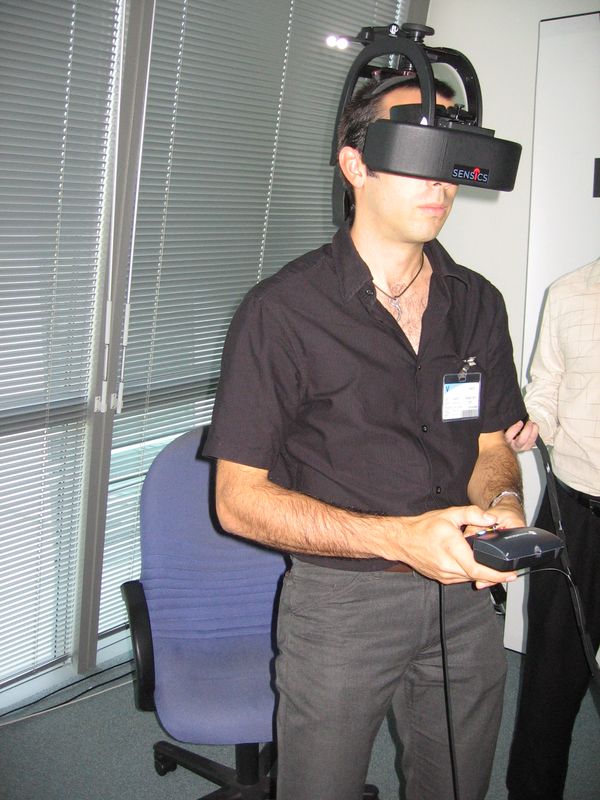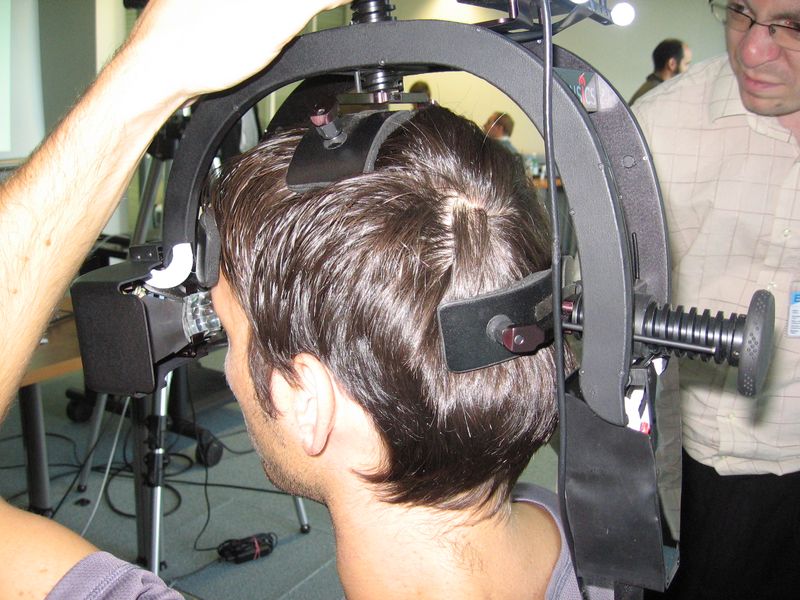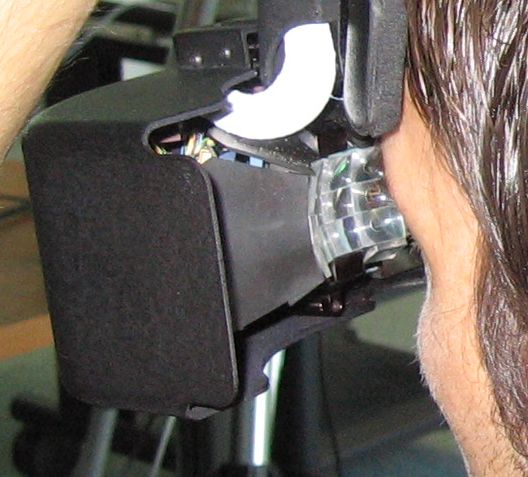I’ve had the chance to test the famous Sensics piSight yesterday. I could only test it for 5 mins, and I think more time would be needed for a better review. Particularly, I’d like to have more time to compare it with a CAVE. Anyway, here’s what I have to say for the moment. I’ll try to compare it to other HMDs and CAVEs.

The piSight is a panoramic HMD, involving 12 (4×3) 800×600 LCDs per eye. So it’s 24 LCDs you have to feed. You can find detailed specifications here. It was running Virtools VRPack demos.
<insert here legal rant about how these are my own personnal opinions and not my employer’s etc..>

– Here’s how I look with it –

– The global design –

– You can see the different lenses here –
On the plus side :
- It’s cheaper and much more transportable than a CAVE. (Note that the SASCube was designed with portability in mind, but you still need one full day to set it up.)
- Compared to other HMDs it’s really panoramic, and that makes a great difference! Much higher resolution too. Higher resolution per degree compared to a CAVE.
- The overlap is good, so you have a good stereoscopic vision.
- It’s light, 1kg
- I wasn’t ill in it, and I’m very sensible to simulators sickness.
- Compared to a CAVE, you have much more liberty of movement (provided that you have a long enough cable and tracking coverage)
- You can buy a HMD with more or less LCDs displays. And if one day you want more, you can easily upgrade, just send it back to Sensics and they’ll send it back to you upgraded.
- Good integration in Virtools VRPack.
On the negative side :
- Calibration : compared to a CAVE where you simply have to wear the shutter glasses, the calibration phase is cumbersome and needs adjustments for each user. And if it’s not perfect, you’ll have artifacts (lenses/displays seams, blur) that really prevent a good immersion. Moreover, you’re not sure when it’s good. You nearly don’t see the seams anymore, but you’re still trying to have a better position. They should have a calibration world, maybe with lines that should be sharp and aligned. Anyway, the calibration phase should really be improved.
- There was dust on several parts of the displays
- The head attachment was a bit loose for me, so when I moved my head, the HMD didn’t exactly follow my head, so the calibration was wrong. I saw the seams and I had to move the HMD back to a good position. I know some people managed to get it tight.
- The lenses are calibrated to work when you look straight ahead, so when you roll your eyes to see on the sides, you start seeing the seams and lose immersion.
- Even with what I thought was a good calibration, I saw differences between displays of one given eye, as if one lens was not totally identical to the others. That disturbed me and at some point I couldn’t see anything but this. But maybe I was too concentrated on trying to find the weaknesses of the display =)
So what’s the conclusion? The panoramic view is really interesting, but the calibration is too imprecise and the slightest movement of the HMD from your head can untune the settings. It didn’t impress me as much as a CAVE or a SASCube. They are still my favorites. This is a gut feeling, not a reasonned one =) I’m in love with CAVEs lol. There are lots of applications when you would use such a HMD. For example I know some scientists are working on movement ancticipation and need the user to physically walk for several meters. This is not possible in a CAVE where most of the movements are made with a joystick. But given an unlimited budget/room space and no good reason to favor a HMD, I’d still use a CAVE.
But as Philippe David once stated in a presentation, and I tend to agree with him, HMDs are the way to go. Or direct retinal display, or hack the optical nerve or whatever. CAVEs are just a hack while waiting for this to come. But there’s still a lot of work to get a perfect HMD, whereas I’m completely in love with the immersion in CAVEs right now.
So we need companies like Sensics to push the HMD forward! Moreover they’re thinking about having mass market HMDs one day! In the meantime I hope they’ll get a better calibration procedure and that they’ll resolve their small optics side-effects. Maybe by using OLED displays they could get rid of the all the lenses and make only one big curved display? Dream on, dream on, ’til your dreams come true =)

OLED gets cheaper these days, so I don’t understand why there are still using LCD displays and I agree with you a curved head-mounted OLED display would be the ideal tradeoff between a full CAVE setup and a portable set.
That said, I’ve read somewhere that OLED displays, being made of organic materials, tend to die quickly. I remember having read something like 200 hours lifetime for standard OLED displays (but I’m a bit confused about why those used for digital cameras or iPods last longer… ?!).
Anyway, stop teasing us with hardware we can’t try!!! 😀
Est ce que les jointures entre les lentilles se voient beaucoup? (Pas la jointure entre les LCDs)
tu ne la vois pas physiquement, mais tu la devines à cause du mauvais placement des lentilles et donc des artefacts.
The piSight does not use LCDs, it uses OLEDs, the same eMagin 800×600 OLEDs you see in the eMagine 3DVisor Z800 (which you can now get for $375 after rebate, along with bundled software, a headtracker, mic, and earbuds – it compares well with the $400,000 piSight with none of that! 🙂
eMagine are working (according to their annual report ’04-5 library.corporate-ir.net/… and the next annual report which I’ve read out there on the net somewhere but can’t find anymore) on 1280(x3)x1024 SXGA OLEDs. So my guess is the next step will probably be a piSight with each eye being 2×2 instead. But making them completely wraparound will need flexible OLEDs, not their current OLED-on-silicon tech that’s taken them to market-leader status.
The problem of short lifetime of OLEDs has been sorted, the estimated lifetime of these displays is about 9 years to half-brightness.
I’ve try it quickly at the Paris Air Show Le Bourget… on Sensics booth.
I’ve to say that effectively you need some time to setup the HMD… vertical overlap and interpupillar distance.
As I tested it very quickly, I don’t know if this was tuned well.
So I’ve liked the high res and the panoramic view but anytime I moved my head, I needed some time for my eyes to adapt (because maybe, the setup was not optimale).
The high res give you the possibility to see very far in the virtual environnment and you can actually roll you eye (which is not possible in other non paranomic HMD).
I will say that I need to test it again…
Alex